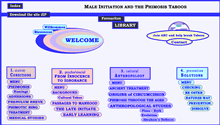|
AFRICAN EROS
Circumcision
Only the circumcised man or warrior (Moran), as he is called
among the herding peoples, can enjoy full freedom of movement and trade,
a freedom which he uses especially in service of the erotic Uncircumcised,
he may not and is not allowed to marry, among the herding and hunting
peoples the same applies to the bride. Only after circumcision will
she be declared by the society as adult and sexually mature. Therefore
among African folk, the boy and girl long for nothing more than to have
the circumcision ritual behind them because it constitutes a milestone
for them in the social standing between two stages in life.
The boy (Layoni) becomes man (Mureniu); the girl (Kyepta)
becomes woman (Osotya). They become new people. Nick names und
childhood names are no more appropriate, from now on the new name they
receive stays with them till the end of their lives, (Nandi.)
Despite the wide spread practice of circumcision by most peoples (in
Africa RS), nothing defintate is known about the origin of
this practice. When anyone is asked about this, they reply either "
zamani!"(1) (with a very long drawn out emphasis on "ma"),
which means as much as "since ancient times"; or he answers
that it is just merely a custom. Both of these are not explanations.
1) A word taken out of the Arabic from the Swahili
language.
Concerning the origin of female circumcision among the Nandi it was
frequently explained to me that the children of the uncircumcised die.
However this is as a logical conclusion of the existing inhuman practice
whereby children of uncircumcised girls are strangled. Thus also it
is not an explanation.
Concerning my questions on female circumcision, a Nandi Chieftan gave
me the following answer: "We are Nandi, we do not want anything hanging
from the women!", With this he made a contemptuous gesticulation
with his little finger as if he wanted to indicate the clitoris. Without
any doubt the men and women from the tribes in question consider the
circumcised sexual organs as beautiful. The circumcised as well as those
not yet circumcised repeatedly assured me of this. However highly one
may estimate the wish for beauty among African races, it appears to
me that this would not be so strong enough to imagine that the origin
of the circumcision ritual was purely for aesthetic
reasons. In addition, not for pure magical-religious reasons. Furthermore
hygienic motives cannot have been the vital ones, as circumcision takes
place many years after the repeated practice of intercourse among both
sexes. "It seems far more to me that the main reason
for circumcision is not difficult to derive from the nature of sexuality.
Men strive to make the often complicated sexual act
as comfortable as possible; and it is beyond discussion, that in this
the foreskin often places a decided restriction in the way, which is
sometimes even painful, for after penetration the glans can be strangulated,
which complicates the act, or, when the prepuce does not lay the glans
bare, which accelerates the ejaculatio seminis. What could
be more obvious than to remove this obstacle, especially since by doing
this one gained a decoration signifying the attainment of maturity.
Of secondary importance was that subsequently, there were several months
of prolongued convalescence, during which the youth now marked as a
man, in the absence of schoolingnow at lasthas the opportunity
to be initiated in all the mysteries of life by his Master. | 
